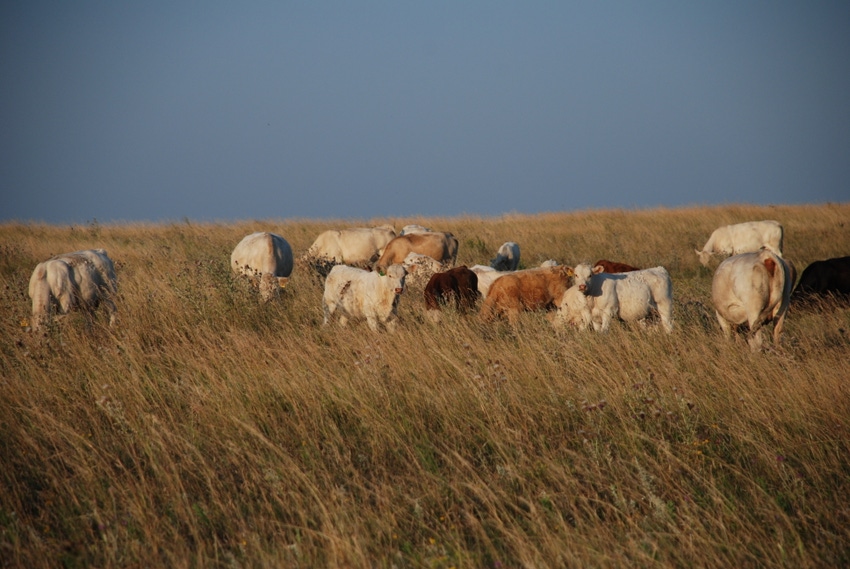“Many backgrounders are facing the realization that they are going to run out of money before their pastures are filled, with stocker cattle prices roughly 25% higher than last year,” AMS analysts say. “Cattle growers may be afforded a rare opportunity to lease pastures in the major grazing areas (like the Flint Hills of Kansas) as grazers start to scale back the number of head they turn out, either due to a lack of capital or a lack of nerve.”
March 14, 2014

“Summer grazers have thrown caution to the high winds as they try to fill their needs
early enough to get their stockers assembled and straightened out before turn-out dates and before offerings completely dry up,” analysts with the Agricultural Marketing Service (AMS) explained Friday.
Stocker cattle and calves traded $2-$6/cwt. higher with the full advance noted in the Southeast, according to AMS.
“Many backgrounders are facing the realization that they are going to run out of money before their pastures are filled, with stocker cattle prices roughly 25% higher than last year,” AMS analysts say. “Cattle growers may be afforded a rare opportunity to lease pastures in the major grazing areas (like the Flint Hills of Kansas) as grazers start to scale back the number of head they turn out, either due to a lack of capital or a lack of nerve.”
As for heavy feeder cattle, AMS analysts explain, “Yearling price levels have reached the point that cattle feeders need more time (with cost-of-gains mostly under $1/lb.) to
cheapen feeders into a profit. Feedlots would like to purchase lighter-weight feeders, but competition from grazers has eliminated this option as summer grass pasture can offer cost-of-gains well under 50¢/lb.”
Subscribe now to Cow-Calf Weekly to get the latest industry research and information in your inbox every Friday!
Feeder Cattle futures were an average of $2.84 higher week-to-week. At auction, though, feeder cattle weighing more than 700 lbs. sold unevenly steady this week, a little higher in farmer-feeder regions and a little lower in the Southern Plains.
That was about the only soft spot in last week’s cattle and beef markets.
Choice carcass cutout value was $4.42/cwt. higher week-to-week at $240.44/cwt. on Friday. Prices achieved a new record earlier in the week at $241.51. Select was $3.63 higher, ending the week at $236.50.
“Packers were looking to enhance their margins with lower fed cattle prices and higher beef prices but feeders were able to keep a toehold and force packers to maintain current price levels,” says Andrew P. Griffith, University of Tennessee agricultural economist, in is weekly market comments.
Cash fed cattle prices in the Southern Plains were mostly steady at $148/cwt., while feedlots in the Northern Plains swapped cattle for $2-$3 higher at $150-$152. Dressed prices were $3.00-$4.50 higher at $240/cwt.
Live Cattle futures were an average of $1.42 higher week-to-week.
“The seasonality of the market would have fed cattle prices remaining elevated at least through April before finding some weakness when more animals come to market as is expected due to the increase in cattle placements the first couple of months of the year,” Griffith explains. “The fundamentals of the beef and cattle industry have a major role in beef prices continuing to escalate. However, the pork and hog industry are providing a lot of support for beef prices as lean hog futures continue surging the $3 daily trading limit and setting all-time highs on the futures market.”
Market fundamentals—especially historically tight supplies—suggest the price floor will remain sturdy and elevated.
“Bullish signals continue to lead the way in the livestock arena with every level of beef product at all-time highs and pork cutouts now perched on historic levels from the challenges pork producers are facing with Porcine Epidemic Diarrhea Virus (PEDv),” AMS analysts say. “The air is indeed getting thin at the current market elevation, but summer contracts on the CME Feeder Cattle board and out-front cash sales of yearlings continue to trade at a slight premium to the spot cash market.”
“Cattle prices for 2014 are raised from last month, reflecting tight supplies and continued price strength for fed cattle,” say analysts with USDA’s Economic Research Service (ERS) in the monthly World Agriculture Supply and Demand Estimates (WASDE) released Monday.
The projected annual average fed steer price was raised on both ends of the range by $6/cwt. to $138-$146/cwt.
More articles to enjoy:
NEW Photo Gallery: New Mower/Conditioners For 2014
How Should Ag Respond To Chipotle's Negative Campaigns?
Proof Of Beef's Sustainability Pays For Everyone
Enjoy A Laugh On Us! 20 Dick Stubler Ranch Life Cartoons
College Student Takes BEEF Editor To Task Over Antibiotic Resistance Article
10 New Farm Trucks To Consider For 2014
Ag Lender Advises Cattlemen To Lock In Interest Rates Now
The Beef Industry's Ultimate Goal Should Be A Satisfied Consumer
Enter The Greeley Hat Works Why I Ranch Essay Contest
120+ Romantic Ranch Photos Submitted By Readers
More Herd Expansion Perspective
Take Steps Now To Cut Feed Costs Next Winter
About the Author(s)
You May Also Like





